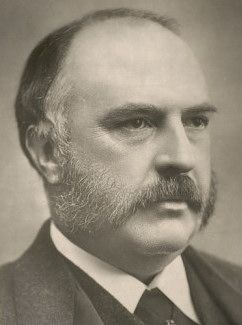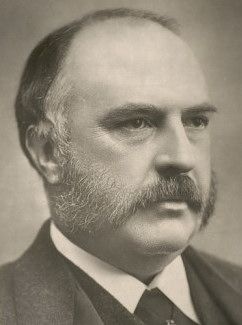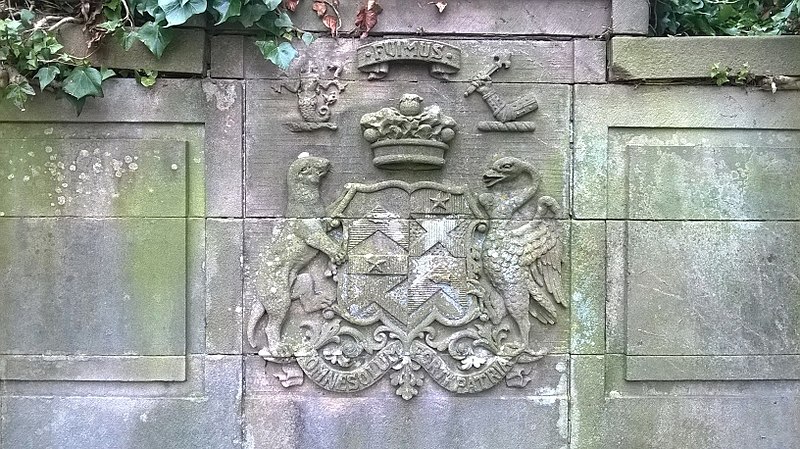Background
The son of Robert Bruce, at one time Tory Member of Parliament for Clackmannan, he was born in Kennet in that county and educated at Loretto, Eton and Oriel College, Oxford. In 1868, four years after his death, Robert Bruce's claim to the peerage was recognised by the House of Lords, and so his son became sixth Lord Balfour of Burleigh on the reversal of the title's attainder by Act of Parliament in 1869.
Political career
In 1876 Balfour was elected a Scottish representative peer. Six years later, he was made an Education Commissioner for Scotland, and in 1887 he entered Lord Salisbury's administration as a Lord-in-Waiting. The following year, Lord Balfour became Parliamentary Secretary to the Board of Trade, a position he held until the Liberals returned to power in 1892, and for three years he chaired the London Water Supply Commission until his return to government as Secretary for Scotland in 1895. Appointed a Knight of the Thistle in 1901, Balfour resigned office two years later with the split that occurred in the Conservative and Unionist Party over Joseph Chamberlain's campaign for tariff reform, a campaign which he opposed.
Banking career
Balfour was Governor of the Bank of Scotland from 1904-1921.
Other public appointments
Balfour was appointed Lord Rector of Edinburgh University (1896–1899), and elected Chancellor of St Andrews University in 1900, a post he held until his death. An active figure in the Church of Scotland, he was President of the World Missionary Conference held in Edinburgh in 1910, and was an important negotiator in the discussions on church union in Scotland which came to fruition in the 1920s. In 1916 he was appointed as chairman of the Committee on Commercial and Industrial Policy. In 1917 he was appointed convener of the Carnegie trust for the universities of Scotland. He became Lord Warden of the Stannaries in Cornwall and a member of the Council of the Prince of Wales in 1908. He was also made a knight of the Thistle in 1901, GCMG in 1911, and GCVO in 1917.
History of Presbyterianism
Balfour wrote An Historical Account of the Rise and Development of Presbyterianism in Scotland, published in 1911 by the Cambridge University Press as part of their series Cambridge manuals of science and literature.
Family
Balfour married Lady Katherine Eliza, youngest daughter of the George Hamilton-Gordon, 5th Earl of Aberdeen, in 1876. They had two sons and three daughters. His eldest son, Robert Bruce, Master of Burleigh, was killed in the First World War. Lord Burleigh of Balfour died at Cadogan Square, London, in July 1921, aged 72. He was buried in Clackmannan. Lady Balfour of Burleigh died in February 1931, aged 78.
Background
The son of Robert Bruce, at one time Tory Member of Parliament for Clackmannan, he was born in Kennet in that county and educated at Loretto, Eton and Oriel College, Oxford. In 1868, four years after his death, Robert Bruce's claim to the peerage was recognised by the House of Lords, and so his son became sixth Lord Balfour of Burleigh on the reversal of the title's attainder by Act of Parliament in 1869.
Political career
In 1876 Balfour was elected a Scottish representative peer. Six years later, he was made an Education Commissioner for Scotland, and in 1887 he entered Lord Salisbury's administration as a Lord-in-Waiting. The following year, Lord Balfour became Parliamentary Secretary to the Board of Trade, a position he held until the Liberals returned to power in 1892, and for three years he chaired the London Water Supply Commission until his return to government as Secretary for Scotland in 1895. Appointed a Knight of the Thistle in 1901, Balfour resigned office two years later with the split that occurred in the Conservative and Unionist Party over Joseph Chamberlain's campaign for tariff reform, a campaign which he opposed.
Banking career
Balfour was Governor of the Bank of Scotland from 1904-1921.
Other public appointments
Balfour was appointed Lord Rector of Edinburgh University (1896–1899), and elected Chancellor of St Andrews University in 1900, a post he held until his death. An active figure in the Church of Scotland, he was President of the World Missionary Conference held in Edinburgh in 1910, and was an important negotiator in the discussions on church union in Scotland which came to fruition in the 1920s. In 1916 he was appointed as chairman of the Committee on Commercial and Industrial Policy. In 1917 he was appointed convener of the Carnegie trust for the universities of Scotland. He became Lord Warden of the Stannaries in Cornwall and a member of the Council of the Prince of Wales in 1908. He was also made a knight of the Thistle in 1901, GCMG in 1911, and GCVO in 1917.
History of Presbyterianism
Balfour wrote An Historical Account of the Rise and Development of Presbyterianism in Scotland, published in 1911 by the Cambridge University Press as part of their series Cambridge manuals of science and literature.
Family
Balfour married Lady Katherine Eliza, youngest daughter of the George Hamilton-Gordon, 5th Earl of Aberdeen, in 1876. They had two sons and three daughters. His eldest son, Robert Bruce, Master of Burleigh, was killed in the First World War. Lord Burleigh of Balfour died at Cadogan Square, London, in July 1921, aged 72. He was buried in Clackmannan. Lady Balfour of Burleigh died in February 1931, aged 78.
Family Members
Sponsored by Ancestry
Advertisement
Explore more
Sponsored by Ancestry
Advertisement











